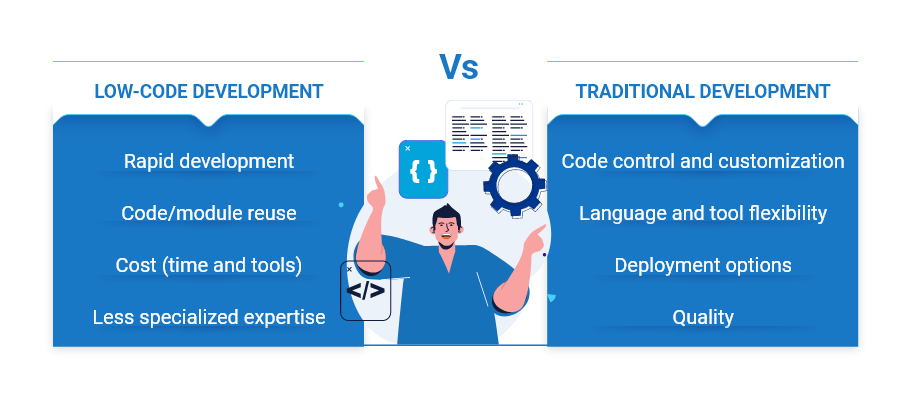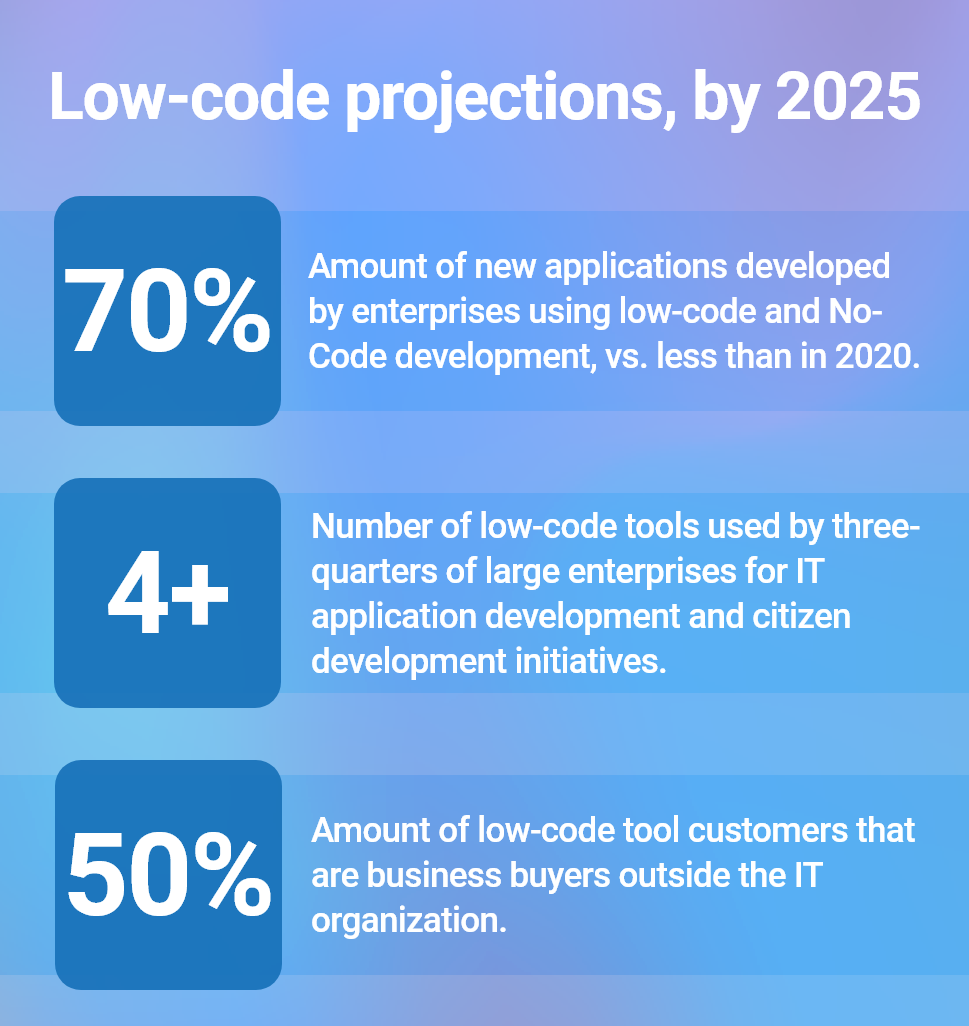Benefits of Low Code Integration for Businesses
- Featured Insights
- May 26, 2023
Businesses will prosper when work cycles compress and value increases. Long-term project roadmaps are a priority for skilled engineers and teams. This intersection results from the emergence of low-code software development projects, tools, and methodologies.
Low code is a method of software development that is visual, highly abstracted, and generally automated. It outlines desired activities at a high level and then depends on tools to build most of the underlying code base. Professional RPA developers and line-of-business (LOB) employees familiar with business issues can use low-code principles and techniques to handle various routine programming tasks. It may free up development teams to concentrate on bigger, trickier tasks.
How Is Low Code Implemented?
Traditional software development has long been a labor-intensive process, with developers meticulously crafting lines of code to bring applications to life. This approach demands extensive knowledge of programming languages, development environments, testing tools, and deployment practices.
In contrast, low-code technology abstracts much of the programming complexity, providing a visual interface and reusable components. Instead of writing individual lines of code, users can simply drag and drop functional components to design the desired software flow. It’s akin to constructing a flow chart to solve a business problem, making it accessible to a wider audience.
While low code offers cost and time savings for rapid development, complex enterprise software may still require traditional methodologies to meet specific performance and functionality needs. The advantages of low code lie in its efficiency and affordability, enabling organizations to deliver solutions faster and at a lower cost. However, projects with unique requirements may necessitate traditional development approaches.
No-code vs. low-code:
Low-code solutions can speed up and simplify a variety of routine business programming activities, but they as per the plan nor intended to do away with all coding altogether. Numerous low-code projects call for some programming expertise to either develop new functional components or alter existing ones and assemble parts in ways that a low-code tool would not support.
No-code systems strive to provide all the intended features and functions and eliminate the need to add or alter components, which means users do not need programming or application design experience. Low-code systems aim to provide all the intended features and functions. Low-code platforms are thought of as a subset of no-code systems.
Principles Of Low-Code Development:
While low code leverages automation, it’s important to note that the platforms and development procedures are not entirely automated. The success of low-code projects relies on a combination of solid business and technological ideas.
Becoming familiar with the low-code platform is crucial. It’s a collaborative effort involving various stakeholders such as RPA developers, business analysts, and project owners. They should collectively evaluate, select, and utilize the low-code platform. Investing time in understanding the platform’s features and capabilities can yield significant benefits, as stakeholders can identify future project uses and add more value to the initiative.
Do not customize:
The predefined components are put into the workflow give low code its power. Members are frequently general and suitable for a wide range of use cases, but they don’t always meet the demands of a particular programming assignment. It is possible to change already-existing components and add new ones, such as user interface (UI) and visual design elements. Still, this customization increases the amount of work (and expense) involved in the development and might undermine the promised speed and simplicity of low-code solutions.
Adjust in general. When an application needs to be customized, consider features in the context of broad or standard use objectives. Create the personalized part with the possibility of reuse in subsequent projects.
Don’t forget about the group:
Even if the project’s requirements may be less complex than those for more conventional software projects, the team that chooses and uses a low-code platform must comprehend the project’s needs and commercial objectives. In quick low-code environments, product owners and other important stakeholders should be accessible to respond to queries and preview builds.
Maintain the business lead:
Iterating and experimenting with new or alternative features and functionalities is simple with low code. Even so, a low-code development can benefit from having a project plan and roadmap. When requirements or features change, business stakeholders should be consulted early and frequently during the testing and evaluation of builds.

What Advantages Do Low-Code Developments Offer?
Low-code development benefits a firm in several ways:
Accelerated rate of development:
Writing individual lines of code and learning complicated syntax takes a lot of work. Low-code technology enables professionals to assemble intricate concepts and workflows as pre-packaged functions or components arranged in a functional visual interface. It can hasten project upgrades and iterations in the future.
A more comprehensive range of workforce options:
In most businesses, skilled developer talent is in high demand. Low code enables programmers with lower skill levels (or even no programming experience) to participate in the software development process since they know the current business objectives well. Any necessary hand-coding or customization is frequently carried out with less assistance from experienced developers.
Increased effectiveness:
Businesses can use low code to develop tools for specific departments. HR might, for instance, need a tool to assist with modeling or forecasting salaries and benefits to make better payroll decisions.
Cheaper innovation:
Through this, companies can test concepts that would be expensive or time-consuming to produce using traditional methods. For instance, a marketing unit could develop a tool to compare the expense of an advertising campaign to the reaction it receives and figure out the most effective ways to reach customers.
The acceptance of specialist ventures:
Low-code systems can quickly and affordably support specialized applications and small user bases. For instance, a company might not have the funds to develop a tool utilized primarily in the finance department, but low code could offer an appealing alternative.
Performance, governance, and compliance management:
Low-code platforms frequently monitor and control the software project and all its related components. As a result, it is simpler for the company to keep control over development and establish rules that promote business governance and compliance. Low-code platforms frequently offer instrumentation, analytics, and reporting that can help gather crucial information about a project’s performance and utilization, aiding teams in planning upgrades and troubleshooting.
The Market For Low-Code Platforms And Their Future:
Due to the COVID-19 global pandemic, which has significantly strained development resources, staff availability, and team relationships, the future of low-code development and platforms will mostly build on the trends and behaviors that formed in 2020. Because the staff is now more dispersed and unavailable, many firms have had difficulty creating apps, portals, web forms, and automated workflows.
With a greater spectrum of IT and business participation, low code lets firms close this gap and build apps for specific business reasons. According to a study by analyst firm Gartner, low-code and no-code development accounted for less than 25% of all application development in 2020 but will make up 75% by 2025. According to In the same study it is revealed Gartner, annual revenues for low-code and no-code platforms will increase from a little over $9 billion to almost $30 billion within that same time.
The advent of cutting-edge technologies like hyper automation and AI greatly enhances the automation capabilities of low code. Hyper automation, which aims to automate all applicable business processes, relies on the fast accessibility and reliability of low-code capabilities. Additionally, AI plays a crucial role in identifying functional requirements for future low-code projects, including defining the project’s objectives and even assisting in the construction process.
As low-code platforms evolve rapidly and automatically, the need to handle defects, perform testing, and ensure coding standards will drive the development of enhanced testing capabilities and further integration of test automation into the CI/CD pipeline.
Ultimately, it is essential for the developer community to embrace the reality of low code and low-code business models. RPA developers must familiarize themselves with low-code platforms to extend and customize components. Close collaboration with low-code practitioners becomes crucial, enabling effective communication with both corporate professionals and “citizen developers” for creating future enterprise applications. Strengthening communication and teamwork skills will be essential for success in this evolving landscape.
